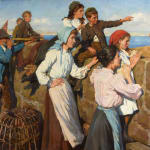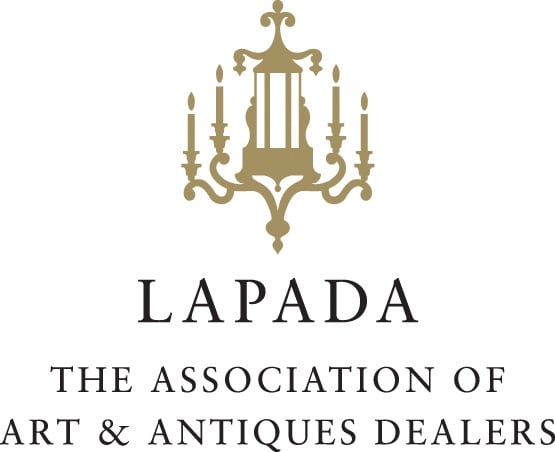Stanhope Alexander Forbes 1857-1947
Framed: 130 x 166 cm.; 51 x 65 in.
Stanhope Forbes was elected a Member of the Royal Academy in 1910 and the pictures that he exhibited at the Summer Exhibition the following year proved that he was deserving of the accolade. The three exhibits also sum up Forbes’ main Newlyn motifs at this time in his life – aspects of the traditional way of life of coastal communities but also the hardships, bonds and challenges of an existence dependent on fishing. The Harbour Window was submitted as his Diploma picture (Collection of the Royal Academy of Arts, London) and depicts a young woman sewing curtains by a sunlit window overlooking Newlyn pier – a scene of tranquil everyday domesticity. The Old Pier Steps (Bradford City Art Galleries) depicts the landing of a successful day’s catch and the interaction between the men who fish at sea and the women who work to prepare the fish for sale and repair the nets. The third exhibit was the most dramatic, a picture full of anticipation and tension – The Fleet in Sight.
It is a sunlit day and those who have gathered at the wall of the old pier to welcome the fishing fleet back to safety, are squinting as they look out to sea, each searching the horizon for the boat of their son, husband or father. Young children point out the familiar red sails of the pilchards boats, whilst women stand patiently – they have watched many times from the same place, each time hoping against tragedy. The sun is shining today and the blue waters are calm but this was not always the case and the ‘old salts’ who are looking out to sea with a telescope – their eyes no longer as strong as they used to be – know that many boats have been lost to the storms and rocks during their lifetimes. The great wall of the sea bastion has taken the force of the ocean for longer than anyone can recall, creating safe anchor for the little boats but beyond its sanctuary the cruel sea is both a giver of life and livelihood and a taker of those who make their living with nets and lobster pots.
The Fleet in Sight was in direct contrast with pictures like Walter Langley’s watercolours For Men Must Work and Women Must Weep of 1883 and Disaster of 1889 (both Birmingham Museum & Art Gallery) in which the perils of the sea have taken their toll. It is likely that this was Forbes’ intention – to present a contrast to the melodramatic scenes painted by Langley, Bramley and himself in the 1880s and 1890s. In 1911 he was commercially successful, at the height of his artistic powers and living a blessed existence among the community of artists and fishermen whose lives were hard but not as hard as they were about to become as war loomed across the sea.
It is clear that by the later stage in the artist’s life, Forbes knew his subject so well and respected the Cornish people to such an extent that he understood their lives and how to depict them with intelligence, warmth and honesty. He and his wife, Elizabeth Stanhope Forbes, had founded the Newlyn Art School several decades earlier, making Cornwall a place of artistic pilgrimage for the next generation of modern artists. Forbes painted among the people, choosing subjects which were immediately engaging and understandable even to those who lived miles from London – his paintings were bought for the municipal galleries in many of the northern industrial towns and cities. Visitors to Cornwall could often find the great painter standing in the cobbled streets with his easel and canvas set up in front of him, working on the oil sketches for his next paintings which would find their way into public and private collections.
The Fleet in Sight was painted in Mousehole, a fishing village on Mount’s Bay, three miles from Penzance. The original quay walls had been built in the fourteenth century and the Southern and Northern piers were added in 1887 and 1888 with huge wooden gates between to seal off the harbour from the sea. At this time the fleet numbered more than sixty boats fishing for pilchards in the North Sea. Forbes had painted several important pictures on almost exactly the same spot, including A Safe Anchorage of 1909 (private collection), The Pier Head of 1910 (Phillips, 17 July 2001, lot 23) and probably also the contemporary The Old Pier Steps. The latter picture appears to depict two of the models that appear in the centre of The Fleet in Sight, local Cornish girls found among the community of Mousehole fisherfolk. Eight years after Forbes painted The Fleet in Sight he painted Fitting Out, Mousehole (Bradford City Art Galleries) in which the old pier can be seen most clearly and we can see that the present picture must have been painted on the raised section of the wall at the top of the flight of stone steps in the upper right of the 1919 canvas.
Whether consciously or not, with The Fleet in Sight Forbes echoed elements from his painting The Seine Boat of 1904 (Phillips, London, 6 June 2000, lot 114) in which, like the present work, the concentration is on the human figures and their gestures. Several poses are reminiscent and the dramatic composition – with a biased left-to-right focus – is very similar. In both pictures, it is the implied scene beyond the confines of the picture that is vast and absorbing of the attention and we, as spectators, are concentrated on the figures all of whom look to an unseen horizon. In The Pier Head (Geelong Art Gallery, Australia), exhibited the previous year Forbes painted a more conventional scene and perhaps the prelude to The Fleet in Sight – in which the fleet is leaving whilst being watched from a similar vantage.
Several oil sketches are known for The Fleet in Sight, including one depicting the principal group of figures (sold Sotheby’s, 25 November 2004, lot 411) and another of the group of male figures to the right (sold Phillips, London, 10 March 1987, lot 17). It was Stanhope Forbes’ usual method to produce elaborate plein air studies for his pictures, concentrating on a particular section of the composition and recording as much detail of light and shadow as possible. These studies would then be used in combination to build up the composition of the finished exhibition painting in the artist›s studio. In 1917 Forbes appears to have returned to the subject and painted a variant of The Fleet in Sight in watercolour (exhibited Messum’s, British Impressions, 2012, no.31) with a related oil sketch (Haddock Collection).
Provenance
Mr Joe Marchman, TexasFor whom sold by Pyms Gallery, London, to Philip, Baron Harris of Peckham, circa 1987
Donated by Lord Harris to a charity auction
Private Collection (purchased from the above)
Exhibitions
London, Royal Academy, 1911, no.118Pyms Gallery, London, Truth to Nature – French, British and Irish Paintings of the Nineteenth and Twentieth Centuries, 1996, no.20
Pyms Gallery, London, Rural and Urban Naturalism – Masterpieces of Late Nineteenth Century French and British Art from the Marchman Collection, 1987, no.23
Literature
Royal Academy Pictures, 1911, illustrated p.83
Pall Mall Gazette ‘Extra’, 1911, illustrated p.24
C. Lewis Hind, Stanhope A. Forbes, R.A., ‘Special Christmas Edition’ of The Art Annual, 1911, p.32
Caroline Fox, Stanhope Forbes and the Newlyn School, 1993, p.89
Elizabeth Knowles, Stanhope Forbes – Father of the Newlyn School, 2017, p.116
Join our mailing list
Be the first to hear about our upcoming exhibitions, events and news
* denotes required fields
We will process the personal data you have supplied to communicate with you in accordance with our Privacy Policy. You can unsubscribe or change your preferences at any time by clicking the link in our emails.




